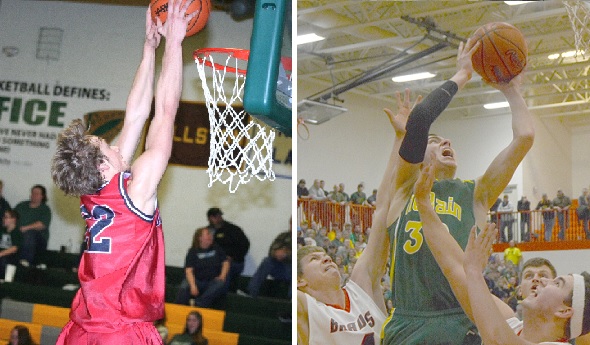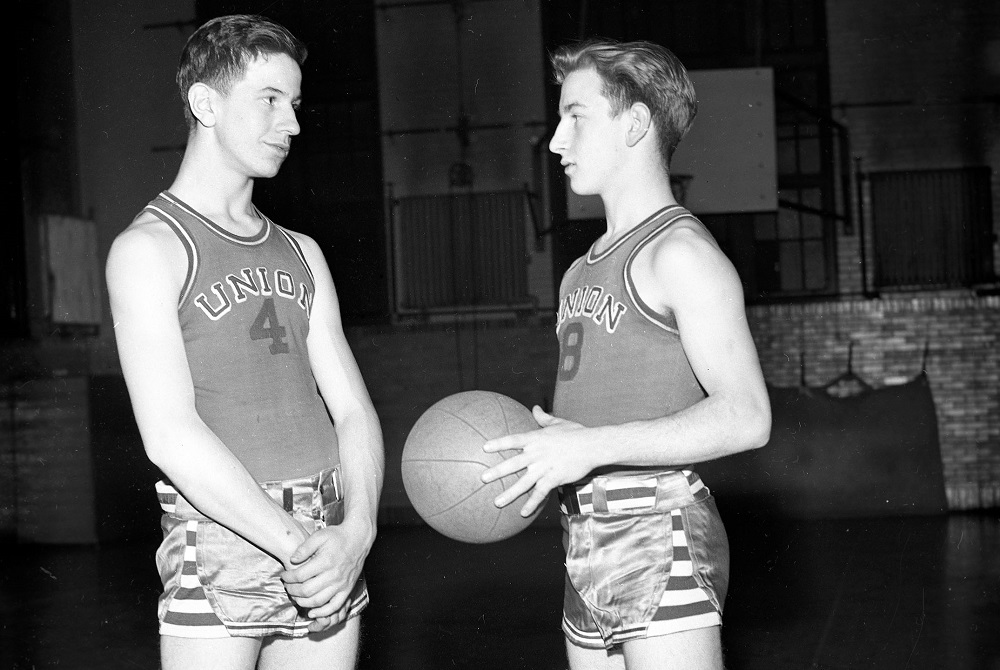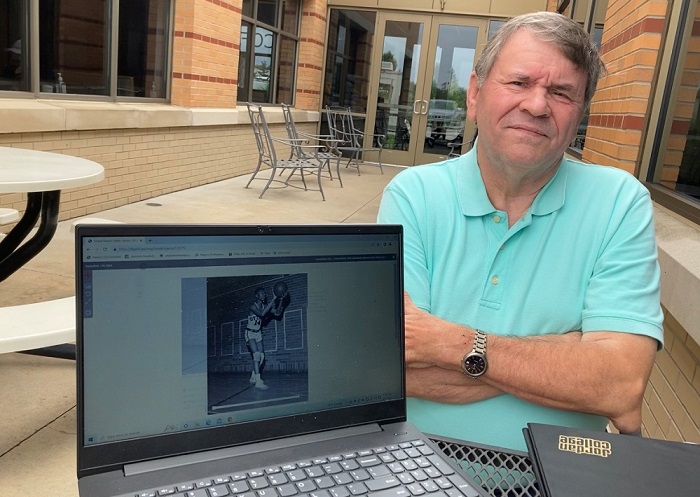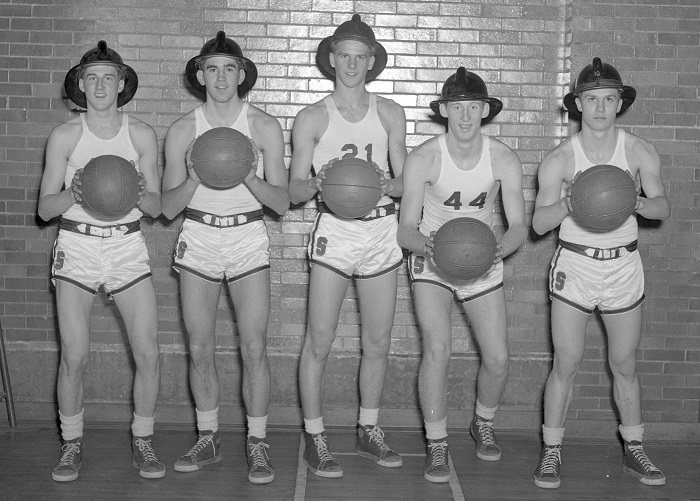
Bellaire, McBain Follow Longtime Leaders
March 22, 2016
By Dennis Chase
Special for Second Half
TRAVERSE CITY – Stan Sexton and Bruce Koopman have been down this road before.
 When Bellaire rallied to edge Buckley last Wednesday, it was the Eagles’ sixth MHSAA Class D Regional basketball championship since 2000 under Sexton.
When Bellaire rallied to edge Buckley last Wednesday, it was the Eagles’ sixth MHSAA Class D Regional basketball championship since 2000 under Sexton.
When McBain knocked off Tawas that same night, it was the Ramblers’ sixth Class C Regional title since 2002 under Koopman.
Now, the two coaches are one win away from leading their programs to a fourth Final Four appearance at Michigan State’s Breslin Center.
In tonight’s Quarterfinals, Bellaire (24-1) faces Fulton (18-6) at Traverse City West while McBain (25-0) takes on Ishpeming Westwood (12-12) at Petoskey.
It should come as no surprise that McBain and Bellaire are still in the mix this last week of the season.
The Ramblers graduated just two seniors off a 22-3 squad that lost in the Quarterfinals to Boyne City last March.
“Having gone through those wars last year and having that experience back has paid huge dividends,” Koopman said.
Sexton can say the same. He returned a solid nucleus from a 19-4 team that lost in the Districts to Boyne Falls.
“We had a good team last year,” Sexton said, “but we could get rattled in tight games. We’ve really developed some poise and confidence this season.”
That was evident Wednesday when the Eagles withstood the pressure to pull out a hard-fought 61-57 victory over Buckley.
“That’s coach’s favorite word - poise, poise, poise,” junior Gabe Meriwether said after the victory. “He wants us to be calm and collected (on the court), to play stable and confident basketball. That’s what we did, and that’s why we won.”
McBain had it a little easier, downing Tawas 63-36 with point guard Garett Gugle leading the way with 19 points. He hit five 3-pointers.
Now, Gugle said, the Ramblers need to stay focused. And the sting from last season’s Quarterfinal loss should act as motivation, he said.
“At this point, everyone is even,” Gugle said. “They’re (Westwood) undefeated in the postseason, we’re undefeated.”
Playing on the big stage in March has become a tradition for both Bellaire and McBain.
The Ramblers won the 2002 Class C title with a lineup that included current Ferris State basketball coach Andy Bronkema, former NFL defensive end Dan Bazuin, and Trent Mulder, an all-Great Lakes Interscholastic Athletic Conference pitcher at Northwood.
This, however, is Koopman’s first team to reach the Quarterfinals undefeated. The 2002 squad lost two games – to eventual Class D champ Wyoming Tri-unity Christian and to Class A Grand Rapids Forest Hills Northern – in a holiday tournament at Cornerstone University. Those losses, Koopman said, turned out to be a blessing in disguise.
“We never lost after that,” Koopman said. “That taught us we had to be tougher, more physical. Had we not played in that tournament, I don’t think we would have won (the Class C title).”
So how does this team compare to the 2002 squad?
 “I don’t know if you can compare teams because there are so many variables,” he said. “I can tell you this, if this team wins another game or two, regardless if they win it all, they deserve to be mentioned in the top two or three during my time here.”
“I don’t know if you can compare teams because there are so many variables,” he said. “I can tell you this, if this team wins another game or two, regardless if they win it all, they deserve to be mentioned in the top two or three during my time here.”
Bellaire came as close as a team can come to winning an MHSAA crown in 2005, only to be denied by Detroit Rogers 71-68 on a miraculous four-point play with 1.6 seconds left in overtime. The Eagles, led by brothers Brandon and Michael McClary, reached the Final Four three times in a four-year span. The McClarys went on to play at Olivet College where Michael became the school’s all-time leading scorer.
The players on this Bellaire team still remember those days.
“When we were younger we looked up to the McClarys when those teams were making their Breslin runs,” senior leader Hayden Niepoth said. “We saw that, and now we want to copy it.”
“They’ll ask, ‘Are we as good as the team of ’05?’” Sexton added. “We (coaches) have to say we don’t have any McClarys on this team, but we have some very good basketball players. We have that important trait the ’05 team had – we’re a team. We play together, we support each other.”
Sexton, who was inducted into the Basketball Coaches Association of Michigan Hall of Fame in 2011, is in his 27th season as the varsity coach. He did a three-year stint from 1978-81, stepped down and then took the job again in 1992. During that span, he’s posted a 493-139 record, a 78 percent win mark.
Koopman is finishing his 22nd season as McBain’s varsity coach. He’s also won 78 percent of his games, compiling a 407-116 record.
To make it even sweeter, Sexton, 74, and Koopman, 50, are coaching at the same schools they attended.
Sexton’s backstory, though, is quite different than most. He did not play sports in high school. And he certainly wasn’t thinking of a coaching career until Bellaire’s head basketball coach Ed Stoneburner approached him one day at school.
“I was teaching fourth grade at the time,” Sexton recalled. “Ed came up and said, ‘I need a fifth and sixth grade basketball coach.’ I said, ‘I don’t know anything about it.’ He said, ‘That’s all right. We’ll teach you.’”
That was in 1971. To this day, Stoneburner’s influence is part of Sexton’s philosophy.
“What I really took from him was to play this game aggressively,” Sexton said. “Play it hard, play it with intensity. That’s what we preach and I think it shows, especially in our defense.”
Sexton also watched and learned from some of the area’s best coaches – Maple City Glen Lake’s Don Miller, Leland’s Larry Glass, Traverse City’s Jim Anderson and Central Lake’s Gary Johnson, among others.
“I’d pay my two or three dollars to get in, and I’d watch these guys coach,” Sexton said.
He would also pore over the boxscores that were published in the newspaper in those days. One line that caught his attention – team fouls.
“I noticed Glen Lake would always have 8, 9, 10 fouls and the other team would have 18, 19, 20 – with guys fouling out,” Sexton said. “Fouling is poor defense. When you’re sending people to the line you’re giving them a 70 percent chance (to score). That’s what impressed me about Glen Lake. You could see the discipline in Don’s teams.”
 Sexton, who also coached girl’ varsity basketball for two years and the baseball team for nearly 20, is aided by a veteran coaching staff that includes Paul Koepke, Jeff Smith and George Mason. All three have been with him for years.
Sexton, who also coached girl’ varsity basketball for two years and the baseball team for nearly 20, is aided by a veteran coaching staff that includes Paul Koepke, Jeff Smith and George Mason. All three have been with him for years.
“Great coaches,” he said. “They bring a lot to the game.”
Koopman, meanwhile, played basketball at McBain under Hall of Fame coach Bruce Brumels in the early 1980s. After graduating, he spent a year working in a factory in Cadillac before enrolling at Central Michigan University.
Four years later in 1989, it was Brumels, then the principal, who hired Koopman as a teacher.
“I was very fortunate,” he said. “Everything fell into place.”
Koopman coached junior varsity basketball for five years under Steve Anderson before taking over the boys varsity program in 1994. In addition, he coached girls basketball from 1990-98 and again from 2003-07. He stepped down soon after the girls season switched to the winter. At that time, he also took on the boys JV coaching duties to go with the varsity.
Koopman cites two reasons for his program’s continued success – community support and great players.
“Let’s be honest,” he said. “Great players make good coaches.”
Perhaps another reason is that McBain starts initiating interest in basketball early on. Right after Koopman was hired, the school instituted a co-ed basketball program for elementary students in grades 3-6. It runs seven consecutive Saturdays, starting in January.
“We had close to 140 kids involved this year,” Koopman said.
The elementary program dovetails into the middle school, the feeder program for the high school. Interest has remained strong. Koopman said 29 players tried out for JV basketball this season.
Koopman – who was mentored by Brumels, Anderson and former girls coach Dale Marie DeZeeuw – brings an “old school” approach to coaching. His practices start with defensive drills, followed by rebounding drills.
“We have some practices where that’s all we do,” Gugle said.
After that comes the offensive drills, where once again discipline is required.
“I’m all about patience, working the ball and looking for that good shot,” Koopman said.
His players get the point.
“He likes the basics,” Gugle said. “Nothing fancy.”
Craig Sterk, a 6-foot-7 junior who “plays everywhere,” leads the Ramblers, averaging 15.2 points and 9.4 rebounds per game. Cole Powell, a 6-3 senior, and Logan Eling, a 5-10 junior, average better than 14 points per outing. Powell is in his fourth year on varsity.
“We have experience, balance and depth,” Koopman said. “We defend pretty well. We rebound pretty well.”
Gugle is in his second season running the point. That experience is invaluable, Koopman said.
“That’s another reason we’re better,” he said. “Whatever teams throw at us doesn’t faze him. He handles it and get us into our offense. He doesn’t look to score, but (Wednesday night) they were leaving him open and he was popping ‘em.”
It’s been an exciting winter for Koopman. His oldest daughter, Michaela, played on the girls varsity team, which advanced to the Regional Finals. His son, Jarrett, is a sophomore on the boys varsity.
The Ramblers were taken to the wire twice during the regular season – both in games outside the Highland Conference. A Jimmy Schneider 3-pointer at the buzzer beat Big Rapids, a Class B quarterfinalist, on the road early in the season. Then a Sterk 3-pointer in the waning seconds forced overtime in a late season win at Frankfort.
Bellaire’s only setback came early in the season to a red-hot East Jordan team, which won the Lake Michigan Conference.
The Eagles ran the table in the Ski Valley, handing Johannesburg-Lewiston its only two regular-season losses. Bellaire also downed Onaway, a Class D quarterfinalist, twice. The Eagles’ tournament resume includes wins over Boyne Falls, Frankfort and Buckley.
“It means a lot (to win a Regional),” Niepoth said. “But we’re not done. We don’t want to just get to the quarters, we want to get to the Breslin, and we want to win at the Breslin. That’s our goal. We just have to keep working and getting better every day.”
Meriwether and Niepoth are the catalysts for the Eagles, averaging 18 and 14 points per game, respectively. Niepoth is also the team’s defensive stopper and assists leader.
“He plays both ends of the court,” Sexton said.
Jamal Lockhart provided some big plays in the win over Buckley, scoring 14 in the low post.
But that’s history now. It’s all about the present and tonight’s Quarterfinals.
“Anybody can beat anybody at this stage,” Meriwether said. “It’s survive and advance.”
 Dennis Chase worked 32 years as a sportswriter at the Traverse City Record-Eagle, including as sports editor from 2000-14. He can be reached at [email protected] with story ideas for Manistee, Wexford, Missaukee, Roscommon, Ogemaw, Iosco, Alcona, Oscoda, Crawford, Kalkaska, Grand Traverse, Benzie, Leelanau, Antrim, Otsego, Montmorency, Alpena, Presque Isle, Cheboygan, Charlevoix and Emmet counties.
Dennis Chase worked 32 years as a sportswriter at the Traverse City Record-Eagle, including as sports editor from 2000-14. He can be reached at [email protected] with story ideas for Manistee, Wexford, Missaukee, Roscommon, Ogemaw, Iosco, Alcona, Oscoda, Crawford, Kalkaska, Grand Traverse, Benzie, Leelanau, Antrim, Otsego, Montmorency, Alpena, Presque Isle, Cheboygan, Charlevoix and Emmet counties.
PHOTOS: (Top) Gabe Meriwether dunks for Bellaire against Fife Lake Forest Area, while McBain’s Cole Powell works for position in the post against Tawas. (Middle) McBain coach Bruce Koopman, far left, stands with his team after its Regional championship win. (Below) Bellaire’s Hayden Niepoth drives to the hoop against Mancelona. (Bellaire photos courtesy of Michael Smith and The Antrim Review; McBain photos courtesy of Marc Vieau and The Cadillac News.)

Longtime Coach Researches Photos to Tell Story of Grand Rapids Sports' Past
By
Steve Vedder
Special for MHSAA.com
September 16, 2022
GRAND RAPIDS – Bob Schichtel always pauses when he comes across the ancient black and white photo long enough to ponder whatever became of the two youngsters adorned in Grand Rapids Union basketball uniforms.
The posed shot shows two players facing each other in a local gymnasium in a photo apparently taken four days after the Japanese surprise attack on Pearl Harbor in 1941 that launched the country into World War II. Only a handful of fans today would recognize the players' striped, ultra-short shots and simple sleeveless shirts with "Union" emblazed across the front as recognizable basketball uniforms. One holds a battered-looking basketball, while the other looks on. The two players, whose uniform numbers are "4" and "9," aren't really smiling, but still seem as close as any teammates, whether 81 years ago or today.
In fact, it's the look the youngsters share that intrigues Schichtel, whose thankless, pro bono job it is to identify the two players.
"Once you start," said Schichtel, a former longtime Grand Rapids basketball coach, "it's like looking down a deep rabbit hole."
 Schichtel works as a volunteer for the Grand Rapids Public Library trying to identify mostly former Grand Rapids City League basketball players from approximately 1938 through the early fifties. The online photos are mostly from the Robinson Photo Studio Collection taken in conjunction with the Grand Rapids Herald newspaper. The library says the unique collection spans some 950 basketball negatives from the entire Robinson/Herald collection that totals well over 900,000 Grand Rapids photos.
Schichtel works as a volunteer for the Grand Rapids Public Library trying to identify mostly former Grand Rapids City League basketball players from approximately 1938 through the early fifties. The online photos are mostly from the Robinson Photo Studio Collection taken in conjunction with the Grand Rapids Herald newspaper. The library says the unique collection spans some 950 basketball negatives from the entire Robinson/Herald collection that totals well over 900,000 Grand Rapids photos.
While the work – which amounts to a ton of patience combined with a detective ability – can be exhausting, it's still what Schichtel describes as a labor of love. For example, there's the shot of the two still-unidentified Union players. Schichtel looks at the photo and can't help but wonder whatever happened to the kids. Were they exceptional athletes? Did they leave their marks on Grand Rapids history, whether it was in education, politics, business, industry, the arts or another field? He doesn't even know, as in many photos from this era, whether the two entered the military and thus even survived World War II.
Schichtel has searched everywhere for the answers, but has come up short. Too many times, in fact.
Which isn't to say he'll quit looking or chalk up his research as inconsequential. Schichtel said the foremost reason he spends hours on the project is that many of the athletes he identifies deserve the recognition for achievements far beyond basketball. In many cases former City League basketball, football, baseball, track and tennis athletes became the foundation on which Grand Rapids was built. If Schichtel can uncover an old photo which depicts these youngsters during their high school careers, so much the better, he said.
"It's important to recognize Grand Rapids sports history, and I don't know if we've given enough attention to their past," Schichtel said. "They are what got us here, and I'm a firm believer they need to be recognized for it."
Figuring out that history, however, ranges from, at the least, extremely time consuming to – in too many frustrating cases – virtually impossible. The City League was formed in the late 1920s and featured original schools Grand Rapids Central, Creston, South, Union, Ottawa Hills, Catholic Central and Davis Tech. The league was eventually folded into the Ottawa-Kent Conference in 2008.
"It was a long, evolving league," Schichtel said.
 The identification tools available to Schichtel are actually more numerous than most would suspect. For starters, he's formed an impressive database of information by pouring through old City League yearbooks and programs, photos from other collections and microfilm of old newspapers, And then there's also the knowledge gathered by Schichtel himself, a 1968 Grand Rapids Catholic Central graduate. After playing in many old City League gymnasiums, Schichtel went on to compile a 389-197 record in 27 years as the Cougars girls basketball coach. He uses countless City League contacts as both a player and coach to identify athletes. In all, Schichtel taught in the Grand Rapids school system for 34 years.
The identification tools available to Schichtel are actually more numerous than most would suspect. For starters, he's formed an impressive database of information by pouring through old City League yearbooks and programs, photos from other collections and microfilm of old newspapers, And then there's also the knowledge gathered by Schichtel himself, a 1968 Grand Rapids Catholic Central graduate. After playing in many old City League gymnasiums, Schichtel went on to compile a 389-197 record in 27 years as the Cougars girls basketball coach. He uses countless City League contacts as both a player and coach to identify athletes. In all, Schichtel taught in the Grand Rapids school system for 34 years.
He also uses the game itself to identify the photos. For instance, he can pinpoint some photos simply by the styles of the uniforms worn by players. He also figures out who is who by other clues such as what the players are doing in the photo. If a player is taking a set shot in the photo, it's likely pre-World War II. The beginnings of the jump shot, or what Schichtel calls "elevation while shooting," is probably mid-1940s. In addition, Schichtel can identify photos through pure basketball athleticism. Players can look a bit awkward in shots from the thirties as compared to players from the late 1940s who were beginning to play with a more obvious flare.
Put all the information together and Schichtel, who has uncovered more than two dozen personal connections to subjects in the photos, believes he has a reasonable shot at identifying them.
Since he signed on with the project, Schichtel figures he's identified about 10 percent of the photos he's viewed. Among the City League athletes he's found shots of Central's John Lavan, who was born in 1890 and played Major League Baseball during the Babe Ruth era and became a military hero who is buried in Arlington National Cemetery; Creston basketball player Roger Wilkins, an assistant United States attorney general during the Watergate hearings; Art Spoelstra of Godwin, a former NBA player and member of the Grand Rapids Hall of Fame; and Grand Rapids native Bill Cutler, who turned a chance post-World War II meeting with then-American League president Will Harridge into a position as commissioner of the Pacific Coast League,
Schichtel said gaining information through photos on the people who became the bedrock of Grand Rapids should be celebrated.
"I think it's a great approach for the community; they shouldn't be forgotten," Schichtel said. "Who else is going to do this? Why do I do it? I see a certain, for lack of a better word, a nobility. These kids played for the love of game, and they became the “Greatest Generation.” These kids did great things. It's not just, 'Well, there's No. 58,’ in a photo.
"You want to know more about them. That's the real intrigue for me."
 Tim Gloege of the Grand Rapids Public Library said the collection of photos – and their identification – is continually growing. As more people log onto the library's website, more people want to either add to the collection or have information that leads to an identification. The library estimates about 1,200 photos are searched monthly. But as time grows, many of the original photos are disintegrating. The library is in a constant state of preservation, Gloege said.
Tim Gloege of the Grand Rapids Public Library said the collection of photos – and their identification – is continually growing. As more people log onto the library's website, more people want to either add to the collection or have information that leads to an identification. The library estimates about 1,200 photos are searched monthly. But as time grows, many of the original photos are disintegrating. The library is in a constant state of preservation, Gloege said.
"It's a massive project, and we're working to get as many photos online as possible," he said. "The numbers (of photos) we have are rising pretty significantly as people post them on social media.
"When you think of the past and now, you need to realize these are people, kids who used to play basketball and did other things. The work is hard and very time-intensive, but it brings a whole new dimension to history."
Schichtel said he's "kind of picked the low-hanging fruit" on many of the easy photos to identify. But the work will continue.
"Yes, it can be frustrating," he said. "There are limitations if you want it to be accurate. Sometimes you look at a photo and you know it's not going to happen, and you move on. But this a chance to learn about people who made Grand Rapids what it is. That's important to me."
PHOTOS (Top) Two Grand Rapids Union basketball players stand for a photo taken Dec. 12, 1941. (2) Longtime area coach Bob Schichtel researches hundreds of photos that are part of the Grand Rapids Public Library archive. (3) Schichtel has identified these 1941 Grand Rapids Ottawa Hills basketball players as James Horn (left) and Chuch Reynier. (4) Schichtel identified Grand Rapids South High’s “Fireman Five” of, from left, Fred Esslair, Lee Morrow, Jack Carroll, Bob Youngberg and Bruce Bigford. (Historic photos courtesy of the Grand Rapids Public Library.)

